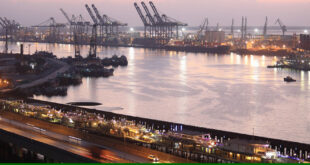While Pakistan is one of the most strategically significant countries in the region, recently inaugurated Gwadar port by Prime Minister Nawaz Sharif is set to open numerous opportunities for trade and industry and other sectors of national economy.
The geo-strategic position of Pakistan is going to play a vital role in the future regional economic outlook. For China, the strategic location of Pakistan is vital in formulating its future strategy in the region and, therefore, China and Pakistan are constructing the economic corridor from Gwadar to Kashghar.
The corridor will help to generate economic activities through a land route connecting Kashgar with Gwadar, where China has already established an economic zone.
It will also reduce sea transportation distance by more than 4,500 nautical miles from Shanghai to major ports of the Gulf region.
Financial experts are unanimous that Gwadar port has huge potential of transforming not only the economy of Pakistan, but also the region. Gwadar port can revive the economy of Pakistan under the fast growing mutual interdependence between the two countries. The connectivity will greatly impact upon the economy of Pakistan as China will invest huge sum of capital in terms of investment, assistance, and transfer of technology in building many mega-projects over a long period of time.
An agreement has been signed with an Iranian company to provide an additional 100MW of electricity to Gwadar by the end of 2017. Furthermore, a new site has been allotted and payment has been made to the deputy commissioner of Gwadar for the construction of the 132KV (AIS) grid station at the deep sea Gwadar Port and an associated 132KV D/C transmission line, official sources claim.
On the other hand, Gwadar international airport is reportedly being constructed at a cost of $260 million, which was a full grant from the Chinese government. The airport would be capable of handling the largest of passenger planes, including A380 Boeing Jet.
Value added
While the economic benefits of ports are usually measured at an aggregate level by indicators such as value added, employment and investment, but in case of Gwadar we failed to make it value added, although much high claims were made, critics told PAGE.
According to them, Gwadar’s coastal location endows it with a potential for development as a world-class port within the framework of the China-Pakistan Economic Corridor to serve as a conduit for sea-borne trade between Pakistan and rest of the world.
They said Shenzhen in Guangdong province in China can be taken as a template for Gwadar’s role in CPEC’s context. Till 1979, Shenzhen was a sleepy fishing village with a population of 20,000.
Today, it is China’s leading city and its population is in the millions. It hosts top global industrial, commercial and financial multinationals. It is the leading container port of the world and its stock exchange is vying with Shanghai for second position in Asia after Tokyo.
Experts believe that Sino-Pak relationship is transforming into an innovative chapter of economic development. China is a growing trading and industrial power and Pakistan could easily benefit from China’s US $11 trillion economy. The two countries enjoy warm relations in all sectors since 1950s.
A great opportunity for Pakistan is to become a ‘Suez Canal’ for China-Pakistan trade in the Middle East. This game-changer project, CPEC, will help Pakistan to have a large number of industrial parks and processing units. The far away and remote areas of Balochistan and Sindh will get a great portion of development from this project.
Pakistan will see a boost in exports with easy access to world markets. The CPEC is a 3,218-Km set-up of roads, railways and dry ports from Gwadar port to Kashgar and will positively impact the lives of about 3 billion people of this region. It will help China through Pakistan to do trade with the half of the world’s countries. This mega project, CPEC, falls into two parts: transportation and energy. An energy master plan of power generation projects to overcome the energy crises would also greatly benefit Pakistan. It is needed to develop and implement a reform roadmap to make it possible without any interruption and hurdles. If everything is fine and goes well, the CPEC will supply up to 6,400MW of energy by 2020.
With the CPEC, there is hope that this project will open up new business outlets for businesspeople from China, Pakistan and Iran. It will also provide a platform of co-operation in huge agricultural sector which would help transmit energy related to agrochemical, pesticides, seeds, and fertilizers.
Furthermore, the CPEC will immensely boost the tourism industry of Pakistan. To achieve maximum economic, industrial and infrastructural benefits through CPEC, greater consensuses in planning, research, co-ordination, security and consultation is needed. There is extensive acknowledgement of the fact that the CPEC is a historic opportunity for Pakistan, they said.
Chinese commitment has been instrumental in the Gwadar project and has been a huge source of investment and technical help in the ongoing development of Gwadar. Overall, China is geared up to take advantage of its strategic relationship with Pakistan and help the region develop peacefully.
Chinese media is foreseeing that with Gwadar, another Dubai is emerging on world’s map, that will change the economic scenario of not only Pakistan but whole of the region.
COPHC, a Chinese company managing the Gwadar port, also said it will start developing the Gwadar Free Trade Zone (FTZ) with an initial investment of $ 150 million. First phase projects in the FTZ include a multi-function business center, a exhibition hall for Chinese goods and cold storage,” COPHC Pakistan chief Wu Chunguo said.
The FTZ and the Gwadar Special Economic Zone are two areas that the Pakistani government has granted preferable policies to attract investments, with tax exemptions for companies inside the two zones for 23 years and 10 years, respectively.
A town with a population of less than 100,000, Gwadar was once a territory of Oman before being purchased by Pakistan in 1958. It is gifted with a natural deep-water harbor that falls close to main shipping lanes and an anchor-shaped peninsula that acts as a breakwater shielding the harbor from the waves of the Arabian Sea.
Seizing the momentum brought by CPEC, the Gwadar government is hoping to develop the coastal town into a modern metropolis with a major port, industrial zones, tourist attractions, recreation grounds and high-end real estate.
Encouraged by the upcoming boom, locals are ready to move on from harvesting fish to harvesting a better life. Dubai is the word often used when the people of Gwadar picture their future, believing the huge opportunities created by CPEC will transform their fishing town to a center of business, shipping and tourism. “What Dubai can achieve, so can we,” future would unfold reality about this.
 PAGE Blog Business Weekly Magazine
PAGE Blog Business Weekly Magazine

